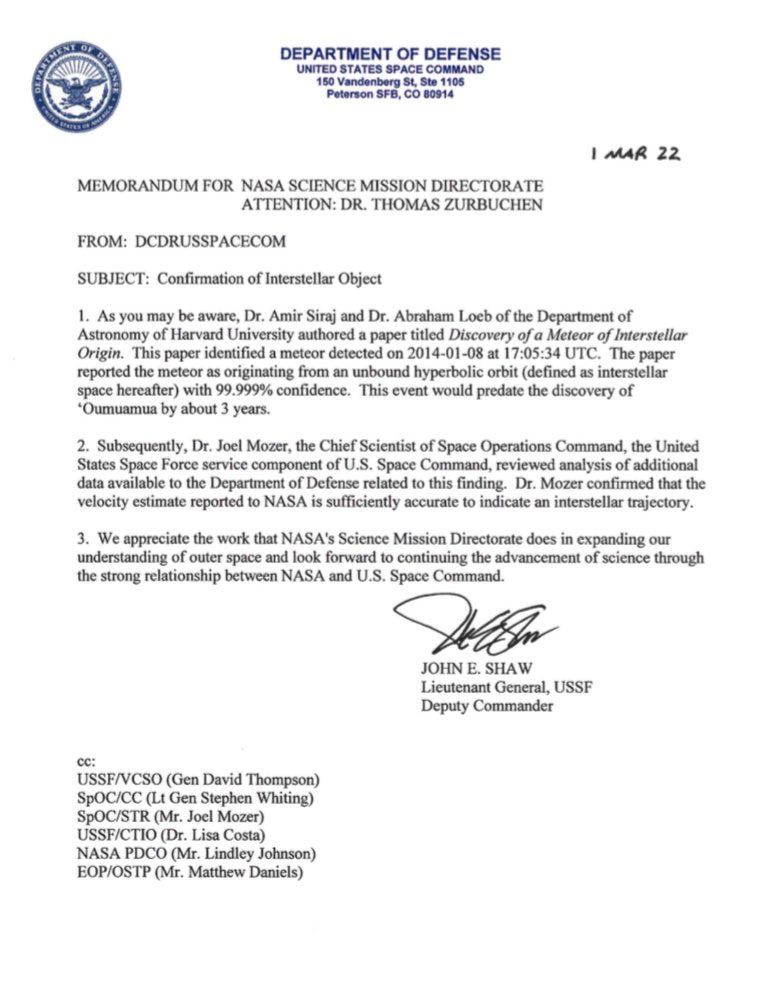Spy Satellites data Confirmed Discovery of the First Interstellar Meteor

U.S. Strategic Command officials confirmed Wednesday that a small meteor that crashed of the Northeast Coast of Papua New Guinea in 2014 actually traveled from another solar system before splashing down into the Pacific.
With the official name, CNEOS 2014-01-08, the meteor crashed on Jan. 8, 2014 with an energy equivalent to about 110 metric tons of TNT into the depths of the ocean.
CNEOS 2014-01-08 was identified as an interstellar meteor in a 2019 study co-written by an undergraduate student at Harvard University, a professor of science at Harvard.
The U.S. Space Command released a document regarding the discovery, where U.S. Space Force Lt. Gen. John Shaw stated that officials reviewed additional data and confirmed that the velocity estimate reported to NASA.

The trajectory of this particular meteor was peculiar, along with the extremely high velocity and unusual direction at which it encountered our planet. So when you put it all together, then the conclusion is that it came from interstellar space.
The fireball was detected by sensors on a classified U.S. government satellite designed to detect foreign missile launches.
The Department of Defense has partnered with NASA and had jointly posted details of the event which were eventuall shared on a public database hosted by the Center for Near Earth Object Studies (CNEOS) within the space agency’s Jet Propulsion Laboratory (JPL).
- NASA Goddard Center Director Shares Plans to Retire
 Dennis Andrucyk, director of NASA’s Goddard Space Flight Center in Greenbelt, Maryland, has announced his intent to retire after more than 36 years of federal service, including multiple leadership roles at NASA and as Goddard’s director since January 2020. Andrucyk will continue to serve as Goddard center director while NASA conducts a nationwide search and… Read more: NASA Goddard Center Director Shares Plans to Retire
Dennis Andrucyk, director of NASA’s Goddard Space Flight Center in Greenbelt, Maryland, has announced his intent to retire after more than 36 years of federal service, including multiple leadership roles at NASA and as Goddard’s director since January 2020. Andrucyk will continue to serve as Goddard center director while NASA conducts a nationwide search and… Read more: NASA Goddard Center Director Shares Plans to Retire - NASA Air’s Space Station R&D, Benefits to Humanity Conference
 NASA will highlight groundbreaking discoveries, benefits for humanity, and how the agency and its commercial and international partners will maximize research and development aboard the International Space Station at the 11th annual International Space Station Research and Development Conference. The conference runs Monday, July 25 to Thursday, July 28 in Washington. The full conference agenda is available… Read more: NASA Air’s Space Station R&D, Benefits to Humanity Conference
NASA will highlight groundbreaking discoveries, benefits for humanity, and how the agency and its commercial and international partners will maximize research and development aboard the International Space Station at the 11th annual International Space Station Research and Development Conference. The conference runs Monday, July 25 to Thursday, July 28 in Washington. The full conference agenda is available… Read more: NASA Air’s Space Station R&D, Benefits to Humanity Conference - First Egyptian and Portuguese Astronauts to join Dude Perfect Cofounder on New Shepard’s 22nd Flight
 Blue Origin today announced the crew flying on its NS-22 mission will include Dude Perfect cofounder Coby Cotton, Portuguese entrepreneur Mário Ferreira, British-American mountaineer Vanessa O’Brien, technology leader Clint Kelly III, Egyptian engineer Sara Sabry, and telecommunications executive Steve Young. Sara will become the first person from Egypt to fly to space; Mario will become the first… Read more: First Egyptian and Portuguese Astronauts to join Dude Perfect Cofounder on New Shepard’s 22nd Flight
Blue Origin today announced the crew flying on its NS-22 mission will include Dude Perfect cofounder Coby Cotton, Portuguese entrepreneur Mário Ferreira, British-American mountaineer Vanessa O’Brien, technology leader Clint Kelly III, Egyptian engineer Sara Sabry, and telecommunications executive Steve Young. Sara will become the first person from Egypt to fly to space; Mario will become the first… Read more: First Egyptian and Portuguese Astronauts to join Dude Perfect Cofounder on New Shepard’s 22nd Flight - NASA to Host Media Activities in Houston Ahead of Lunar Mission
 Ahead of the Artemis I flight test, NASA is inviting media to its Johnson Space Center in Houston Friday, Aug. 5, for a detailed mission briefing and a behind-the-scenes look at facilities that will enable a long-term human presence at the Moon. NASA is currently targeting no earlier than Monday, Aug. 29, for the launch of the… Read more: NASA to Host Media Activities in Houston Ahead of Lunar Mission
Ahead of the Artemis I flight test, NASA is inviting media to its Johnson Space Center in Houston Friday, Aug. 5, for a detailed mission briefing and a behind-the-scenes look at facilities that will enable a long-term human presence at the Moon. NASA is currently targeting no earlier than Monday, Aug. 29, for the launch of the… Read more: NASA to Host Media Activities in Houston Ahead of Lunar Mission - Virgin Galactic Announces New Spaceship Manufacturing Facility in Mesa, Arizona
 Capacity to Produce Up to Six Spaceships Per Year, Significantly Increasing Flight Frequency Will Bring Hundreds of New Highly Skilled Jobs to Greater Phoenix Area MESA, Ariz. – July 14, 2022 – Virgin Galactic Holdings, Inc. (NYSE: SPCE) (the “Company” or “Virgin Galactic”), an aerospace and space travel company, today announced it has signed a… Read more: Virgin Galactic Announces New Spaceship Manufacturing Facility in Mesa, Arizona
Capacity to Produce Up to Six Spaceships Per Year, Significantly Increasing Flight Frequency Will Bring Hundreds of New Highly Skilled Jobs to Greater Phoenix Area MESA, Ariz. – July 14, 2022 – Virgin Galactic Holdings, Inc. (NYSE: SPCE) (the “Company” or “Virgin Galactic”), an aerospace and space travel company, today announced it has signed a… Read more: Virgin Galactic Announces New Spaceship Manufacturing Facility in Mesa, Arizona







